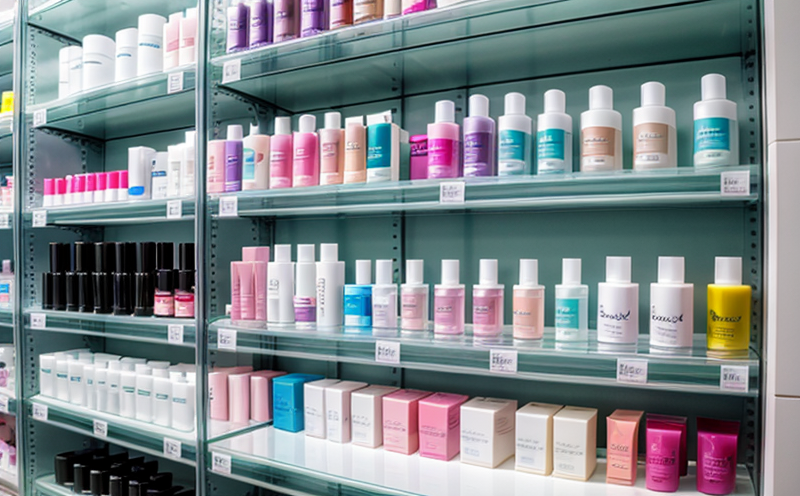Phase Separation Stability Testing in Emulsions
The stability of emulsions is a critical factor in the formulation and quality assurance of cosmetic products. Emulsion formulations are inherently complex, involving multiple phases that can interact in ways that affect product performance over time. Phase separation stability testing evaluates whether an emulsion remains stable under specified conditions, ensuring consistent product quality throughout its shelf life.
The process involves creating a controlled environment where the emulsion is subjected to various stresses such as temperature, humidity, and agitation. These conditions simulate real-world storage scenarios that the product might encounter during distribution and use. The goal is to identify any changes in the physical structure of the emulsion, particularly phase separation, which can lead to compromised product efficacy or safety.
Phase separation occurs when the continuous and dispersed phases within an emulsion become unstable, leading to a separation into distinct layers. This phenomenon is not only aesthetically displeasing but also indicative of potential quality issues that could impact consumer satisfaction and brand reputation. By conducting rigorous stability testing, manufacturers can ensure that their products meet regulatory standards and maintain consistent performance over time.
The methodology for phase separation stability testing typically involves the following steps:
Sample preparation: The emulsion is prepared according to standard procedures, ensuring consistency across samples.
Stress application: Samples are subjected to various environmental stresses such as temperature cycling (e.g., 4°C and 37°C), humidity control, and mechanical agitation (e.g., shaking).
Monitoring: The emulsion is monitored at regular intervals for signs of phase separation. Visual observation, rheological analysis, and instrumental methods like differential scanning calorimetry (DSC) are used to assess structural changes.
Data interpretation: Results are analyzed to determine the onset and rate of phase separation, providing insights into the emulsion's stability over time.
The use of advanced instrumentation such as high-performance liquid chromatography (HPLC) and Fourier-transform infrared spectroscopy (FTIR) can provide deeper insights into the chemical composition and structural changes within the emulsion. These techniques help in understanding not just the physical state but also any subtle compositional shifts that could contribute to phase separation.
The importance of this testing cannot be overstated, as it directly impacts product performance, safety, and consumer satisfaction. By identifying potential stability issues early on, manufacturers can make informed decisions about formulation adjustments or process improvements. This ensures that products meet not only regulatory requirements but also the high standards expected by consumers in the cosmetics industry.
Industry Applications
Phase separation stability testing is particularly relevant for emulsion-based cosmetic formulations, including:
| Product Type | Description |
|---|---|
| Creams and lotions | These products often contain water-in-oil (W/O) or oil-in-water (O/W) emulsions, which can be prone to phase separation. |
| Foams and mousses | Emulsion-based foams require stability to maintain their structure and prevent settling of components. |
| Sunscreens | The emulsions in sunscreens must remain stable under prolonged exposure to sunlight, which can lead to photodegradation and phase separation. |
In addition to these specific product types, the testing is also crucial for ensuring the longevity of other cosmetic formulations such as mousses, shampoos, conditioners, and cleansing products. The ability to predict and prevent phase separation is essential in maintaining product quality and consumer trust.
| Environmental Conditions | Testing Impact |
|---|---|
| High temperature | Can accelerate phase separation, making it a critical parameter to monitor during testing. |
| Low humidity | May lead to increased viscosity and potential freezing points, affecting emulsion stability. |
| Shaking | Mechanical stress can cause rapid phase separation, highlighting the need for robust formulations. |
The testing process is also applicable across various stages of product development and production. From initial formulation design to final packaging and distribution, stability testing ensures that each step contributes to a high-quality end product.
Customer Impact and Satisfaction
Ensuring the stability of emulsions is directly linked to customer satisfaction and brand reputation. Unstable products not only fail to meet consumer expectations but can also lead to negative reviews and a loss of trust in the brand. By investing in phase separation stability testing, manufacturers can:
- Ensure consistent product quality across batches
- Avoid recalls due to compromised product integrity
- Increase customer satisfaction by delivering products that meet expectations
- Enhance brand reputation through reliable and high-quality products
The ability to predict and mitigate potential issues early in the development process can lead to cost savings and improved efficiency. This is particularly important for large-scale manufacturers who produce vast quantities of cosmetic products.
Beyond immediate quality improvements, phase separation stability testing also supports long-term brand growth by fostering a culture of continuous improvement. Regular testing helps identify trends in product performance, allowing companies to refine their formulations over time. This proactive approach not only enhances product longevity but also ensures compliance with international standards and regulations.
International Acceptance and Recognition
The importance of phase separation stability testing is universally recognized across the cosmetics industry, with several international standards guiding best practices:
ISO 21064:2013: This standard provides guidelines for the testing of cosmetic emulsions and lotions. It specifies methods for evaluating the stability of these products under various environmental conditions.
ASTM D5879-12: This American Society for Testing and Materials standard outlines procedures for the accelerated stability testing of cosmetic products, including emulsions.
EN 330:2006: Developed by CEN, this European standard provides a framework for the evaluation of cosmetic products' shelf life under defined conditions.
IEC 62781-4:2015: Although primarily focused on medical devices, this international standard can be adapted to ensure that emulsions used in cosmetics meet stringent stability requirements.
The widespread adoption of these standards demonstrates the global consensus on the importance of rigorous testing for ensuring product quality and safety. Compliance with these guidelines not only facilitates market entry but also enhances a brand's credibility and appeal to international consumers.





